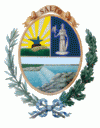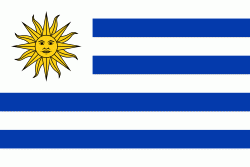Salto (Salto)
 |
During the Guarani War the governor of Rio de la Plata, José de Andonaegui, and the Marquis of Valdelirios pleaded with Governor José Joaquín de Viana to move north with an army of 400 men and enforce the terms of the Treaty of Madrid. In October 1756 Viana built several barracks for his army located in the area who had to survive on hunting and fishing. The sheds he built were called San Antonio del Salto Chico. Thus, the short-lived first settlement in the present city of Salto dates from 8 November 1756, which remains as its date of foundation. Some people say it was "by chance", such as the writer Francisco Bauza in his book Dominación española en Uruguay. In 1757, Viana and the superior Governor of Buenos Aires, Pedro de Cevallos, built a strong fort called San Antonio. The fort had a chapel, which was under the patronage of San Antonio de Padua. Also in that period, Spanish troops captured the Portuguese colony at Colonia del Sacramento and used its facilities for seven years before abandoning it in 1763.
On 16 June 1768, the buildings in Salto were occupied by Francisco de Paula Bucareli with 1,500 soldiers seeking to expel the Jesuits from all Spanish territory, as ordered by Carlos III. The fort of San Antonio served as an arms depot and later as a prison for most of the priests, who were later taken to Buenos Aires or deported overseas. While the Jesuits were imprisoned Lieutenant Nicolás García took care of the fort and three boats. A big flood of the Yapeyú River caused considerable damage and the fort was rebuilt at a nearby site, this time on the western side of the Uruguay River in the current Concordia area, in order to act as a river-road junction. In early 1782 the settlement already had permanent residents.
On 12 February 1811 Francisco Javier de Elío declared war on the Board of Buenos Aires. Montevideo was besieged by José Rondeau and José Gervasio Artigas, so Elío asked for help from Portugal. Later the Spanish and the Board of Buenos Aires had to sign an agreement, because Buenos Aires was blockaded by sea. In an armistice agreement it decided to lift the siege of Montevideo and the blockade of the Rio de la Plata. However, General Artigas had to withdraw to the north in what became known at the Exodus of the Western People. Among the members of the Exodus of the Western People were a considerable number of important people in Uruguayan history, including some 6,000 military personnel and 4,500 civilians. In December 1811 they camped for one month on the Uruguay River very close to Salto. In that place the Board of Buenos Aires awarded the title of Lieutenant Governor, Chief Justice and Captain of the Department to Artigas who "guided the revolutionaries in a ten-year crusade to liberate the people from Imperial Spanish rule." After the Battle of Las Piedras on 18 May 1811, Artigas was named "Chief of the Orientales". After 1820, Artigas was forced to live in exile in Paraguay but his movement had been very successful and led to the establishment of the First Republic of Uruguay on 25 August 1825.
Before the Independence of Uruguay Salto had acquired the category of "Pueblo" (village) and on 16 May 1835, by Decree, it was recognized as being a "Villa" (town). Then, on 16 June 1837, Salto was made capital of the department by the Act of Ley Nº 158.
In late October 1845 roughly 1,000 of Giuseppe Garibaldi's Italian and Uruguayan troops advanced up the Uruguay River and took Gualeguaychú in Argentina before seizing Salto, remaining there several months as they plotted against Justo José de Urquiza, Cesar Diaz and Servando Gomez. On 8 February 1846 Garibaldi defeated Gomez's army, killing several hundred at San Antonio Chico Creek outside Salto. Garibaldi lost about a hundred men in the battle. Montevideo accepted him as General on February 16 when news of his victory reached the city.
On 8 June 1863 Salto's status was elevated to "Ciudad" (city) by the Act of Ley Nº 780, which was reaffirmed on 3 March 1869 by the Act of Ley Nº 1.000.
During the late 2010s, Salto city saw a spate in criminal activity similar to those of other border cities across Latin America like Ciudad Juarez, Mexico, with drug trafficking and femicides among the principal crimes committed. According to Nicolas SantAnna, the president of the local commerce and industry syndicate, Salto's Don Atilio has become Uruguay's most dangerous barrio.
Map - Salto (Salto)
Map
Country - Uruguay
 |
 |
| Flag of Uruguay | |
The area that became Uruguay was first inhabited by groups of hunter–gatherers 13,000 years ago. The predominant tribe at the moment of the arrival of Europeans was the Charrúa people, when the Portuguese first established Colónia do Sacramento in 1680; Uruguay was colonized by Europeans late relative to neighboring countries. The Spanish founded Montevideo as a military stronghold in the early 18th century because of the competing claims over the region. Uruguay won its independence between 1811 and 1828, following a four-way struggle between Portugal and Spain, and later Argentina and Brazil. It remained subject to foreign influence and intervention throughout the 19th century, with the military playing a recurring role in domestic politics. A series of economic crises and the political repression against left-wing guerrilla activity in the late 1960s and early 1970s put an end to a democratic period that had begun in the early 20th century, culminating in the 1973 coup d'état, which established a civic-military dictatorship. The military government persecuted leftists, socialists, and political opponents, resulting in deaths and numerous instances of torture by the military; the military relinquished power to a civilian government in 1985. Uruguay is today a democratic constitutional republic, with a president who serves as both head of state and head of government.
Currency / Language
| ISO | Currency | Symbol | Significant figures |
|---|---|---|---|
| UYU | Uruguayan peso | $ | 2 |
| ISO | Language |
|---|---|
| ES | Spanish language |















